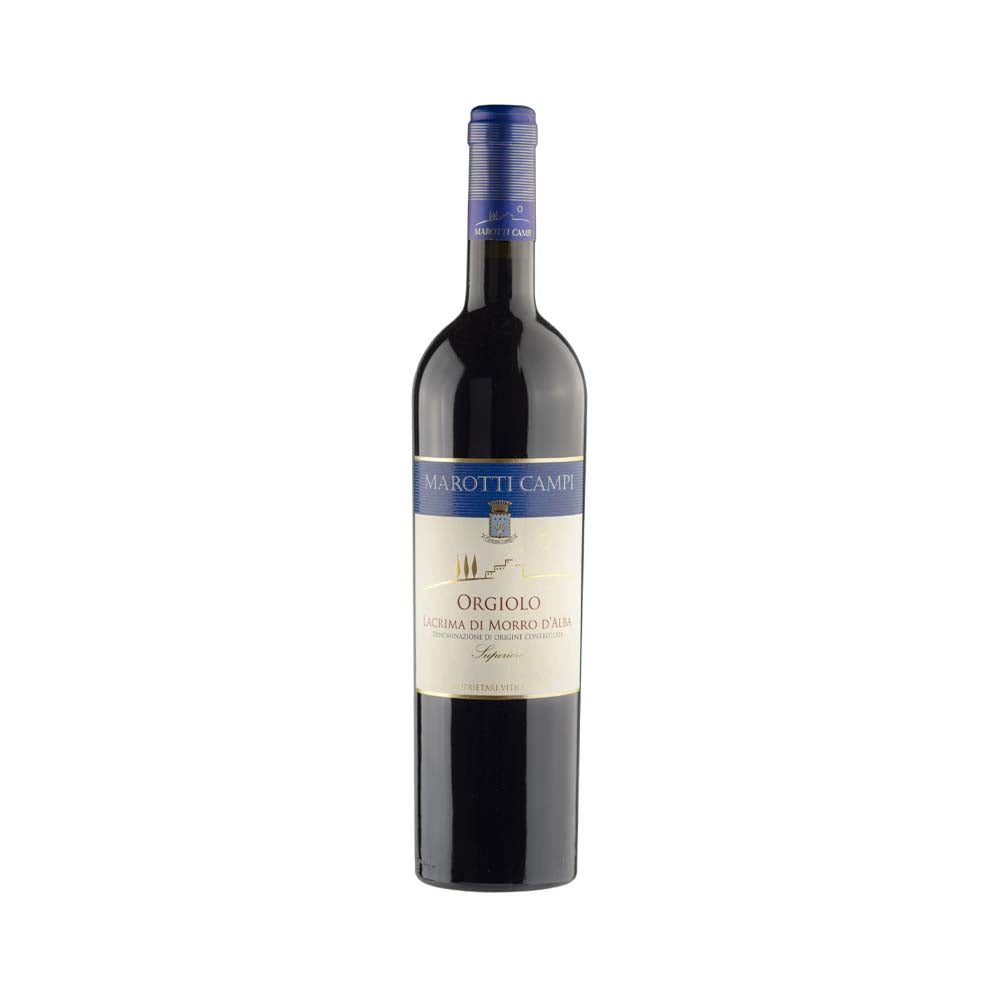
Lacrima di Morro d'Alba Orgiolo | Marotti Campi
DENOMINATION: Lacrima di Morro d'Alba DOC
TYPOLOGY: red
GRAPE: Lacrima di Morro d'Alba 100%.
ORIGIN: Italy, Marche
AGEING POTENTIAL: 4/5 years
SERVING TEMPERATURE: 18° C
GLASS: wide red wine glass
ALCOHOL: 14% vol.
FORMAT: 75 cl
THE WINE
TECHNICAL SPECIFICS
FRESHNESS: ◼︎◼︎◼︎◼︎◻︎
BODY: ◼︎◼︎◼︎◼︎◻︎
SAPIDITY: ◼︎◼︎◼︎◼︎◻︎
SOFTNESS: ◼︎◼︎◼︎◼︎◻︎
TANNICITY: ◼︎◼︎◼︎◼︎◻︎
NOTES BY OUR SOMMELIERS
👁 a red with violet hues;
👃🏻 on the nose it expresses a fruity bouquet (blackberry and cherry), spicy (pepper), floral (ripe rose), Mediterranean scrub and juniper
👄 on the palate it is soft, velvety, round. It closes with a finish characterised by a vegetal and floral aftertaste.
FOOD PAIRINGS
Lacrima di Morro is a soft, structured wine with important floral notes. It lends itself very well with traditional Marche dishes endowed with intensity and persistence. Perfect with first courses with elaborate sauces, it also goes well with white and red meats cooked with various preparations. Try it with duck breast.
WINE-MAKING AND REFINEMENT
Lacrima is a very special grape variety, cultivated only in the area around the municipality of Morro d'Alba. It is said that even Federico Barbarossa appreciated it in the 12th century, when he settled in these territories to assault nearby Ancona.
The grapes macerate in contact with the skins for 10-14 days, fermenting in steel at a temperature of 18° C, then ageing for a year in used oak barrels. A red that verges on perfection.
YOU WILL LOVE IT FOR...
its softness and complexity.
ORIGIN
TERROIR
The area is Morro d'Alba, 10 km from the Adriatic Sea, in the hills between Senigallia and Jesi, north of Ancona. The hills are of Cretaceous origin, with limestone basalts mixed with clays and sands on which alluvial marls and sediments of marine fossils from the original formation of the region during the closing and opening of the Strait of Gibraltar rest. On the surface layers, on the other hand, we find sediments of brown marls of alluvial character and pluvial sands. The climate is affected by the proximity to the coast, but is also characterised by the hilly nature of the area and the presence of the Lower Elisa Valley and the Triponzio and Guardengo streams. This results in cold, wet winters and hot, sultry summers. The main grape variety cultivated is lacrima. The name Lacrima is said to derive from the fact that the grape skin, once ripe, cracks, allowing the juice to drip, to tear. The remarkably thick skin, during maceration, provides the wine with a very substantial supply of anthocyanins, tannins and colouring substances. It is vigorous, productive and constant; it is susceptible to both pests and viral diseases. It prefers hilly clay and sandy soils, rich in minerals, which are well present in this area. It needs sun and ventilation, and is harvested at the end of September.

WINERY
The Marche region has one of the most beautiful landscapes in Italy. Gentle hills and cultivated fields follow one another in a landscape that alternates between the sea and the mountains, representing the best of the Italian countryside. Just a few kilometres from Ancona, the regional capital, is the small municipality of Morro d'Alba, one of the Castelli di Jesi, built around 1000 A.D. as a military fortress; here, in the Sant'Amico district, there is a young but already renowned winery: Marotti Campi. Founded in 1999, the winery's origins, however, go back as far as the mid-19th century, when the Marotti family bought the first land and built a villa right in the centre of the estate, which at the time was centred on sharecropping. As the decades passed, the focus turned to viticulture, and in 1991 Giovanni Marotti Campi began an ambitious modernisation process, culminating in 1999 with the first Marotti Campi harvest. Today, the winery is still run by Giovanni, with the help of his wife Francesca and son Lorenzo. They mainly cultivate the two symbolic vines of the area, Verdicchio and Lacrima di Morro d'Alba, as well as a small percentage dedicated to Montepulciano, Petit Verdot, and Cabernet Sauvignon; agricultural practices are carried out with the utmost respect for the surrounding nature, trying to minimise environmental impact.
When will I receive my order?
If the bottle is in stock it will be sent immediately and you will receive it in a couple of working days.
Is the order renewed?
No, this product is not bound by any type of subscription and cannot be renewed.
Is there a minimum number of bottles?
No, you do not have to order a minimum quantity of bottles: you can choose to receive just one bottle of each type.

This product has no reviews yet.
